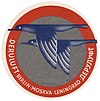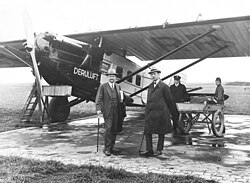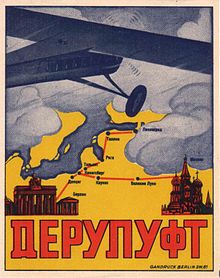Deruuft
| Deruluft (Дерулюфт) |
|
|---|---|

|
|

|
|
| IATA code : | |
| ICAO code : | |
| Call sign : | |
| Founding: | 1921 |
| Operation stopped: | 1937 |
| Seat: |
Berlin , German Empire |
| Turnstile : | |
| Company form: | Corporation |
| Passenger volume: | 13689 (1936) |
| Fleet size: | 6 (+6 chartered) |
| Aims: | International |
| Deruluft (Дерулюфт) ceased operations in 1937. The information in italics refer to the last status before the end of operation. |
|
Deruluft ( De utsch- Ru ssische air traffic AG) was a 1921 by Aero Union AG Berlin and the Soviet trade mission , founded in Germany joint German-Soviet airline.
history
On November 24, 1921, the head of the Soviet Russian commercial agency in Berlin, Boris Stomonjakow, and the director of the German Aero-Union AG , Ferdinand Rasch, signed a contract to establish a German-Russian aviation company. The Aero-Union was a holding company of HAPAG , Luftschiffbau Zeppelin GmbH and AEG , founded just a few months earlier on April 21, 1921 , which was founded with the aim of bundling common aviation interests. Metallgesellschaft Frankfurt and the mining and metal bank associated with it later took part in the holding company.
The newly founded German-Russian company was named Deutsch-Russische Luftverkehrs AG, or Deruluft, for short, and was endowed with initial capital of 5 million Reichsmarks, half of which was raised by both shareholders. On November 24, 1921, the government of Soviet Russia granted Deruluft a license to operate air traffic between the German Reich and Soviet Russia (from December 30, 1922, the Soviet Union ) for an initial period of five years .
On May 1, 1922, Deruluft opened regular services on the Königsberg - Kaunas - Smolensk - Moscow route . A new line from Berlin via Riga and Tallinn (Reval) to Leningrad was established on June 6, 1928. Both routes were operated until March 31, 1936. In the first year of operation, the flights took place twice a week in each direction during the season from May to October. The 1200 km flight from Berlin to Moscow took 22 hours. In 1923 the weekly flights were increased to three, in the following year there were first four flights a week, from July 1924 on every day.
In 1923 the Aero-Union and the Lloyd-Luftdienst merged to form Deutsche Aero-Lloyd , which in turn merged with Junkers-Luftverkehr AG with the participation of the Reich on January 6, 1926 to form Deutsche Luft Hansa AG . With this, Deruluft had become a 50% subsidiary of Lufthansa.
The first aircraft were Fokker built in the Netherlands : a Grulich V 1 and nine F.III . The fleet was later expanded to include German Junkers F 13 , Rohrbach Roland and Albatros L 58 .
At the beginning of the flight activity only mail and officials were transported. The company was not opened to the general public until August 27, 1922. Initially, the route from Königsberg to Moscow was served by five German and five Soviet crews twice a week, from 1923 three times and one year later daily. In 1925 the Berlin – Moscow line was opened. In 1926, Deruluft flew the Moscow – Charkow route for three months in cooperation with the Ukrainian Ukrwosduchputch . It was the competitive pressure of state-supported foreign airlines and the new customs of this branch of industry that forced Luft Hansa to expand its routes and, in a joint effort with the Soviet Union, to add flight connections to Asia. In a strange way it which benefited Communist International from a collaboration of the press department of the Deutsche Luft Hansa with the New German publisher , the production of second-hand as a customer gift from Alexander Rado took designed range maps, and its owner, the Western propaganda chief Willi Münzenberg , strong could fly cheaply, "to all corners of the German Reich and in 15 hours to Moscow". In August 1926 Deruluft joined the IATA . In 1928 the route network comprised 2,640 kilometers. From 1929 the early Fokker F.III were replaced by Dornier Merkur . At the beginning of 1931, Tupolev ANT-9s were added to the fleet. In 1934 five Junkers Ju 52 / 3m followed . From 1922 to 1934, the airline carried 39,168 passengers on the German-Soviet routes and covered 9,800,000 kilometers.
As part of the secret air force cooperation (to Rapallo ), Deruluft also delivered German aircraft to the Soviet Union, which were used at the jointly operated training airfield near Lipetsk.
With the increasing deterioration of the German-Soviet relationship after the Nazis came to power , the Deruluft was dissolved on March 31, 1937.
development
List of passenger and cargo volumes from 1922 to 1931
| year | Route flown | Passengers carried | Freight carried | Airmail carried |
|---|---|---|---|---|
| 1922 | 174,768 km | 338 | 17.915 t | 1,047 kg |
| 1923 | 215,480 km | 382 | 23,487 t | 1,589 kg |
| 1924 | 352,786 km | 552 | 34,519 t | 2,382 kg |
| 1925 | 492,237 km | 1,463 | 54.059 t | 5,410 kg |
| 1926 | 514,185 km | 1,192 | 25,892 t | 10,733 kg |
| 1927 | 630,542 km | 1,809 | 49.694 t | 25,574 kg |
| 1928 | 790,465 km | 2,510 | 69.886 t | 27,992 kg |
| 1929 | 839,655 km | 2,692 | 75.238 t | 16,711 kg |
| 1930 | 950,512 km | 2,947 | 62,351 t | 27,244 kg |
| 1931 | 945,317 km | 3,660 | 87.690 t | 29,060 kg |
See also
literature
- Rainer Göpfert: Successful teamwork in aviation. The German-Russian Air Transport A. G. DERULUFT. Part 1 . In: FLiEGERREVUE X . No. 41 . PPVMedien, 2013, ISSN 2195-1233 , p. 30-43 .
- Rainer Göpfert: Successful teamwork in aviation. The German-Russian Air Transport A. G. DERULUFT. Part 2 . In: FLiEGERREVUE X . No. 42 . PPVMedien, 2013, ISSN 2195-1233 , p. 14-37 .
- Wilfried Copenhagen : Lexicon Soviet Aviation . Elbe-Dnjepr, Klitzschen 2007, ISBN 978-3-933395-90-0 .
- Karl-Dieter Seifert: German air traffic 1926–1945 - on the way to world traffic . In: German aviation . tape 28 . Bernard & Graefe, Bonn 1999, ISBN 3-7637-6118-7 , pp. 215-222 .
- Wolfgang Wagner: German air traffic - the pioneering years 1919–1925. (= Die deutsche Luftfahrt Volume 11), Bernard & Graefe, Koblenz 1987, ISBN 3-7637-5274-9 .
- R. E. G. Davies: Aeroflot. An Illustrated History of the World's Largest Airline . Airlife, Shrewsbury 1992, ISBN 1-85310-411-6 .
Web links
- Documents and newspaper articles on Deruluft in the 20th century press kit of the ZBW - Leibniz Information Center for Economics .
Individual evidence
- ↑ a b Lutz Budrass: eagle and crane: Lufthansa and its history from 1926 to 1955 . Karl Blessing Verlag, 2016, ISBN 978-3-641-11246-2 , chap. 1 "Healthy competition": the airlines 1919–1925.
- ^ Karl-Dieter Seifert: 100 years of passenger aircraft. The beginnings of German aviation. In: Fliegerrevue X. No. 79. PPV Medien, Bergkirchen 2019, ISSN 2195-1233 , p. 29.
- ^ Fritz Voigt: Traffic: Second volume, second half: The development of the traffic system . tape 2 . Duncker & Humblot, Berlin 1965, p. 741-742 .
- ↑ Wolfgang Wagner: The German Air Traffic – The Pioneering Years 1919–1925. Bernard & Graefe, Koblenz 1987, ISBN 3-7637-5274-9 , p. 280.
- ↑ Gerald D. Feldman: The Deutsche Bank from the First World War to the Great Depression. 1914-1933. In: Lothar Gall et al.: The Deutsche Bank 1870–1995. Publishing house CH Beck. Munich 1995, p. 248.
- ^ Babette Gross: Willi Munzenberg. A political biography. Stuttgart 1967, p. 190.
- ↑ Helmut Erfurth: Airplane legend Ju 52. GeraMond, Munich 2013, ISBN 978-3-95613-401-2 , pp. 134/135.
- ↑ Karl-Heinz Eyermann , Wolfgang Sellenthin: The air traffic of the USSR . Society for DSF, 1967, pp. 6 and 7
- ↑ Wolf Oschlies: Symbiosis of the outlaws . Preussische Allgemeine Zeitung, No. 38, September 19, 2009.
- ↑ Karl-Heinz Eyermann, Wolfgang Sellenthin: The air traffic of the USSR . Society for DSF, 1967, p. 6.
- ↑ This date is controversial. Erhard Milch, on the other hand, names November 11th as the founding day, whereas Aero-Lloyd and Aero-Union unanimously name November 24th in a manuscript dated March 1, 1923. See also the literature cited (Budrass, p. 61; Göpfert, p. 37; Seifert, p. 215 and Wagner, p. 47.)
